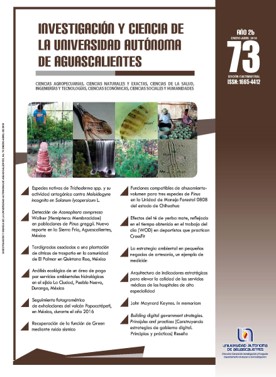Photogrammetric follow-up of the Popocatepetl volcano exhalations in Mexico during the year 2016
DOI:
https://doi.org/10.33064/iycuaa201873205Keywords:
volcano, Popocatepetl, crater, photogrammetryAbstract
The following work shows a study about the recent activity of the Popocatepetl volcano, analyzing images of the eruptive columns of the same and supported by terrestrial and satellite photogrammetry tools for their classification; the emanation of gases, ashes, height and direction were calculated. After 67 years, on December 21, 1994 the volcano had an eruptive activity. The columns reached up to 3 km altitude, the ash emission increased and the seismometers indicated tremors of the movement of the magma in the structure.
This event marked the reactivation of the volcano, this study shows an analysis of the surface and perimeter of the crater, to determine the deformations that it has suffered until 2016 generated by the activity that the volcano has experienced; for this study, satellite images and application of specialized software for its processing were used.
Downloads
References
Espinasa-Pereña, R. (2014). Historia de la actividad del volcán Popocatépetl. 17 años de erupciones (65 pp.). México: CENAPRED. Recuperado de http://www.cenapred.gob.mx/es/Publicaciones/archivos/225-HISTORIADELAACTIVIDADDELVOLCNPOPOCATPETL-17AOSDEERUPCIONES.PDF
Espinasa-Pereña, R., & Martín-Del Pozzo, A. L. (2006). Morphostratigraphic evolution of Popocatépetl volcano, México. En C. Siebe, J. L. Macías, & G. J. Aguirre Díaz (Eds.), Neogene-Quaternary continental margin volcanism: A
perspective from Mexico: Geological Society of America Special Paper 402 (pp. 101-123). US: Geological Society of America. doi: 10.1130/2006.2402(05)
Hawaii Institute of Geophysics & Planetology. (s. f.).MODVOLC, Near- real- time termal monitoring of global hot-spots [Portal electrónico de consulta]. Recuperado el 23 de octubre de 2017, de http://modis.higp.hawaii.edu/cgi-bin/modisnew.cgi
Macías, J. L. (2005). Geología e historia eruptiva de algunos de los grandes volcanes activos de México. Boletín de la Sociedad Geológica Mexicana, 379-424.
Marcial, J. (1996). Popocatépetl. Vivir en riesgo. Ciencias, 41(enero-marzo), 50-55. [En línea]. Recuperado de http://www.revistaciencias.unam.mx/pt/148-revistas/revistaciencias-
/1225-popocat%C3%A9petl-vivir-en-riesgo.html
Planet. (s. f.). Welcome to the insights economy [Portal electrónico con imágenes en movimiento]. Recuperado de https://www.planet.com/
United States Geological Survey. (s. f.). EarthExplorer [Portal electrónico de consulta]. Recuperado el 23 de octubre de 2017, de https://earthexplorer.usgs.gov/OTRAS FUENTESBibliografía
Bolla, G. L., Cassano, A. M., & Franco, J. M. (2009). Estabilidad de barrancas sobre el río Paraná-Modelado por Métodos Numéricos (119 pp.). Paraná: Universidad Tecnológica Nacional.
Campbell, J. B. (2002). Introduction to remote sensing (pp. 20-59). US: CRC Press.
Cortés-Ramos, J., & Delgado-Granados, H. (2012). The recent retreat of mexican glaciers on Citlaltépetl Volcano detected using ASTER data. The Cryosphere Discussions, 6, 3149-3176.
Dóniz, F. J. (2002). El volcanismo basáltico de la dorsal de Pedro Gil en la isla de Tenerife. Papeles de Geografía, 35, 101-114.
García, F., Ramos, E., & Domínguez, R. (1996). Posible flujo de lodo en el costado oriente del volcán Popocatépetl. En Volcán Popocatépetl. Estudios realizados durante la crisis de 1994-1995 (pp. 109-119). México: Sistema Nacional de Protección Civil-Centro Nacional de Prevención de Desastres-
Universidad Nacional Autónoma de México.
Ontiveros, G., Delgado, H., & Cortés, J. (sometido a dictamen para publicación). The surface energy balance of Glaciar Norte on Citlaltépetl volcano, Mexico during 2006-2009. Geofísica Internacional.
Palacios, D., & Vázquez-Selem, L. (1996). Geomorphic effects of the retreat of Jamapa glacier, Pico de Orizaba volcano (Mexico). Geografiska Annaler: Series A, Physical Geography, 78, 19-34.
Ramos-Aguilar, R., Máximo-Romero, P., González-Castelán, Y. J., & Montiel-Peralta, B. A. (2005). Monitoreo y vigilancia del volcán Citlaltépetl o Pico de Orizaba (análisis geomorfológico). Revista Geofísica, 61, 33-45.
Ramos-Aguilar, R., Máximo-Romero, P., Montiel-Peralta, B. A., González-Castelán, Y. J., & Rodríguez-Marcos, A. (2008). Análisis fotogramétrico del volcán Citlaltépetl. Revista Cartográfica, 84, 105-116.
Ramos-Aguilar, R., Máximo-Romero, P., Soto-Cruz, B. S., Alcántara-Iniesta, S., & Vázquez-García, M. C. (2014). Análisis geoestadístico de las barrancas Colorada y Quimichule del volcán Popocatépetl (México) como aporte a la prevención de desastres naturales. Investigaciones Geográficas, 47, 67-82.
Schenk, T. (2002). Fotogrametría digital (Geomática Vol. I). España: Marcombo-ICC.
Downloads
Published
How to Cite
License
Las obras publicadas en versión electrónica de la revista están bajo la licencia Creative Commons Atribución-NoComercial-CompartirIgual 4.0 Internacional (CC BY-NC-SA 4.0)









